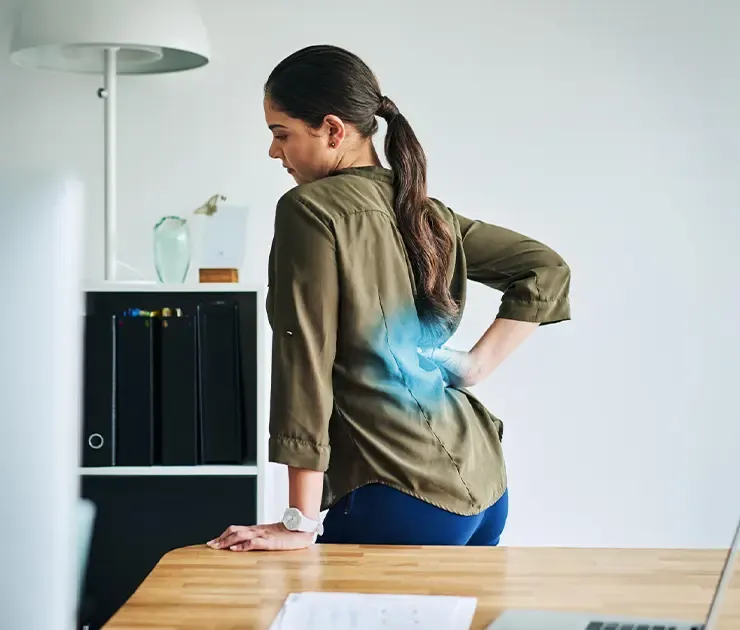Mid-Back Pain
What may cause my mid-back pain?
Mid-back pain that comes on suddenly is typically due to acute injuries such as injured discs or torn muscles. Sports injuries, falls, using poor lifting techniques, and overexerting yourself are common causes of acute mid-back pain.
You can also develop long-term mid-back pain from repetitive strain or doing the same activities that cause acute pain. Doing the same movements many times over long periods can irritate and inflame tissues in and around your spine, causing mid-back pain and soreness that worsen when you perform these activities.
Another type of mid-back pain is caused by age-related deterioration. This includes conditions like osteoarthritis, degenerative disc disease, spinal stenosis, spondylolisthesis, and vertebral compression fractures stemming from osteoporosis. Disc herniation can also happen because of age-related deterioration.
Other causes of mid-back pain include spinal abnormalities like scoliosis, where the spine has a left and/or right curvature. Spinal cord injuries, tumors, and internal diseases like kidney infections can also cause mid-back pain.

What is degenerative disc disease?
Disc degeneration can be caused by a number of factors. Degenerative disc disease (DDD) refers to the wearing down of the intervertebral discs as you get older or from trauma or congenital circumstances. Intervertebral discs separate the bones (vertebrae) in your spine, acting as a cushion and shock absorber. These discs also allow you to bend and twist your mid-back with ease.
As you get older, the intervertebral discs begin to collapse due to the loss of collagen fibers and water, affecting the space between the spinal bones. Typically the pain from DDD is most notable with forward bending, sitting, and sitting while bending forward.
Degenerative disc disease may also lead to other mid-back problems that cause pain, such as disc herniation, spinal stenosis (narrowing in the spine), or spondylolisthesis (vertebral bone displacement).
Most people 40 and older have some amount of disc degeneration, but not everyone develops pain. We treat patients based upon their physical examination, MRI, and presentation. We do not diagnose just based upon imaging alone.
What is a slipped disc - formally known as disc protrusion and herniation?
A disc protrusion is a milder form of a herniation, which is usually due to microscopic injury to the outer ring of the disc (annulus). Intervertebral discs separate and cushion the space between each vertebra. These discs have a tough exterior and a gel-like interior.
Disc herniation means the gel-like material in the intervertebral disc is pushing against the outer ring of the connective tissue surrounding the entire disc. The displaced disc material may irritate or compress a spinal nerve or the spinal cord, causing pain.
You can develop disc protrusion and herniation following an acute injury, such as a car accident or heavy lifting. However, you’re more likely to get a disc injury as you get older due to age-related degenerative changes, making the discs more vulnerable to tears and herniations.
Can I have pain that radiates into my legs with disc herniation?
If you have disc protrusion and herniation in the er mid-back (lumbar spine), it may irritate the nerve roots that are exiting the spine through the foramen. This can cause pain that radiates down the front, side, or mid-back of the leg. This layman’s term is sciatica.
What is facet joint pain?
The facet joints are small joints, about the size of knuckles, that are located on the mid-back of the spine. These joints take on about 15% of the weight load of the spine. When a disc herniation or DDD develops and the disc becomes less thick, this results in the top portion of the facet joint to move closer to the bottom portion of the joint. When this occurs over time, arthritis develops. Arthritis can be thought of as developing potholes in the road. Arthritis results in exposed bone with free nerve endings that can transmit pain.
What is stenosis of the central, lateral recess, and foramen?
Central stenosis refers to narrowing in the central spinal canal where the spinal cord runs, while lateral recess stenosis is narrowing in the space where the nerve root exits the spinal canal. Foraminal stenosis is narrowing within the intervertebral foramen, the opening where the nerve root fully exits the spine.
Central, lateral recess, and foraminal stenosis can be caused by a number of conditions, including congenital narrowing, aging, injuries, diseases, and trauma. These conditions often result in irritation of the nerve roots which will cause mid-back and radiating pain around the rib cage.
How is mid-back pain diagnosed?
The Bioinfinity Regenerative Medicine team has extensive experience diagnosing mid-back pain. We review your medical history, complete a physical exam, and ask about your symptoms. Imaging procedures such as an MRI, CT scan, or X-rays are often needed to all your provider to see the bones and tissues inside your spine so they can identify the cause of your mid-back pain.

